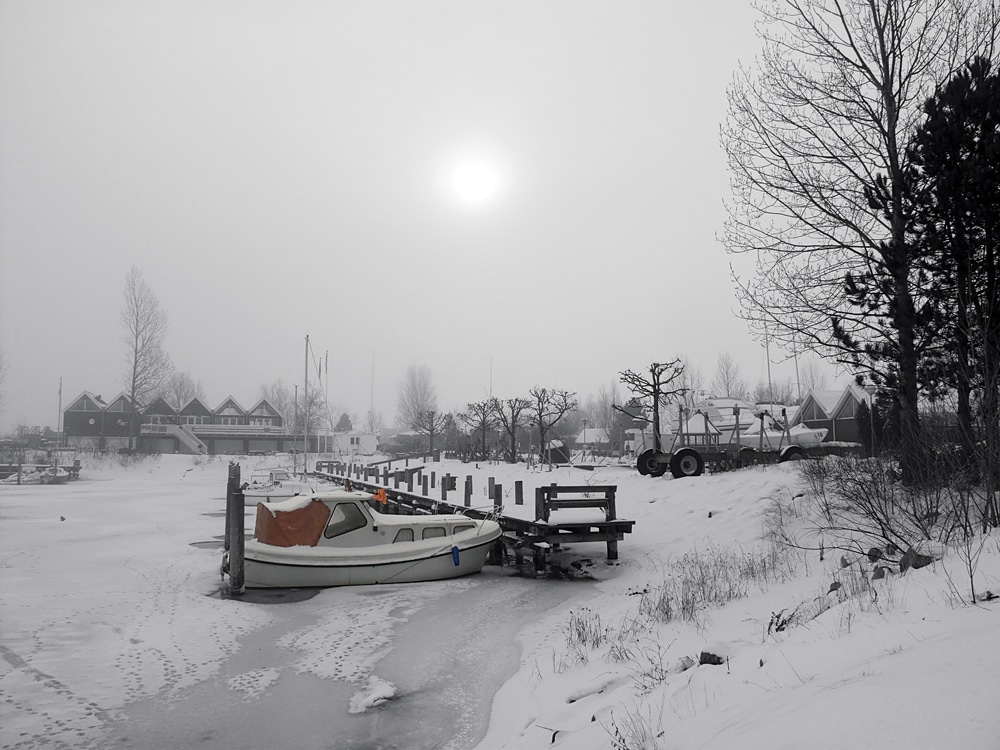
Top Winterizing Tips
Winterization is a necessary evil of boat ownership, combining an annual health checkup and insurance for an easy start to next spring’s boating.
Paying a boatyard might lighten your wallet between $150 and $1,000, or even more depending on what type of boat and how many engines you have.
You can do it yourself with hand tools, an afternoon’s time and some pretty inexpensive supplies. You’ll need a place to work, with running water and adequate ventilation. You’ll also want a service manual, perhaps a helper, and the following tips and techniques.
Winterization starts with prepping the fuel supply long before the day you haul out for the winter. The engine’s fuel supply should be treated for storage during the last week or so of your boat’s in-water use. In so doing, you ensure that properly “stabilized” fuel has been run through the tank, feed lines and engines prior to laying the boat up for months.
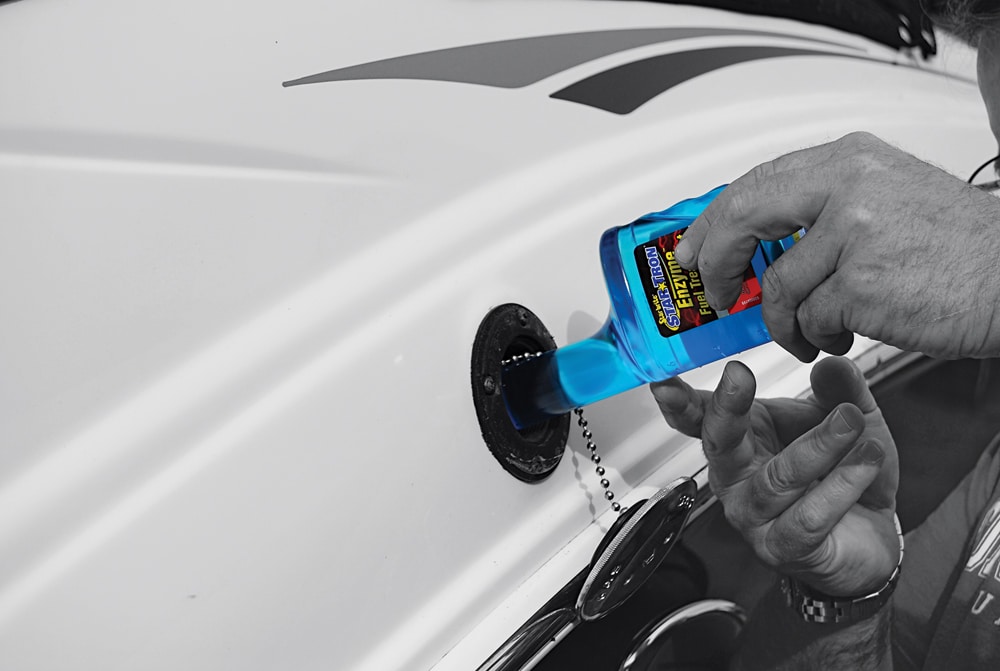
Top Winterizing Tips
Add fuel stabilizer in the “winterize dosage” during your last fuel-up prior to storage. This way the engine ingests stabilized fuel, and by fueling up after adding the stabilizer, the chemicals mix better in the tank. Stabilizing fuel properly is more important than ever with the presence of E10 fuel. Boating Magazine
I suggest products such as Star brite’s Star Tron marine fuel treatment (starbrite.com) or Gold Eagle’s Sta-Bil treatment (goldeagle.com/brands/stabil). Engine manufacturers also sell fuel treatment, typically available from the dealer. The questionable and inconsistent quality of today’s unleaded fuels makes this step necessary to prevent fuel from phase-separating over time and leaving fuel injectors or carburetors gummed up with stale, varnished fuel. I like to “overmedicate” the fuel that’s in the tank; I typically double the dosage that the bottle’s instructions call for. I’ve been doing this for more than 25 years with excellent results.
As for the fuel level in the tanks, there are many opinions on this. The ideal situation would be to empty the tanks as much as possible and get all the fuel out of the system — including the engine’s fuel lines and carburetors/fuel injectors. However, this is not always practical to do — it’s difficult to get all the fuel out and also winterize the engine at the same time.
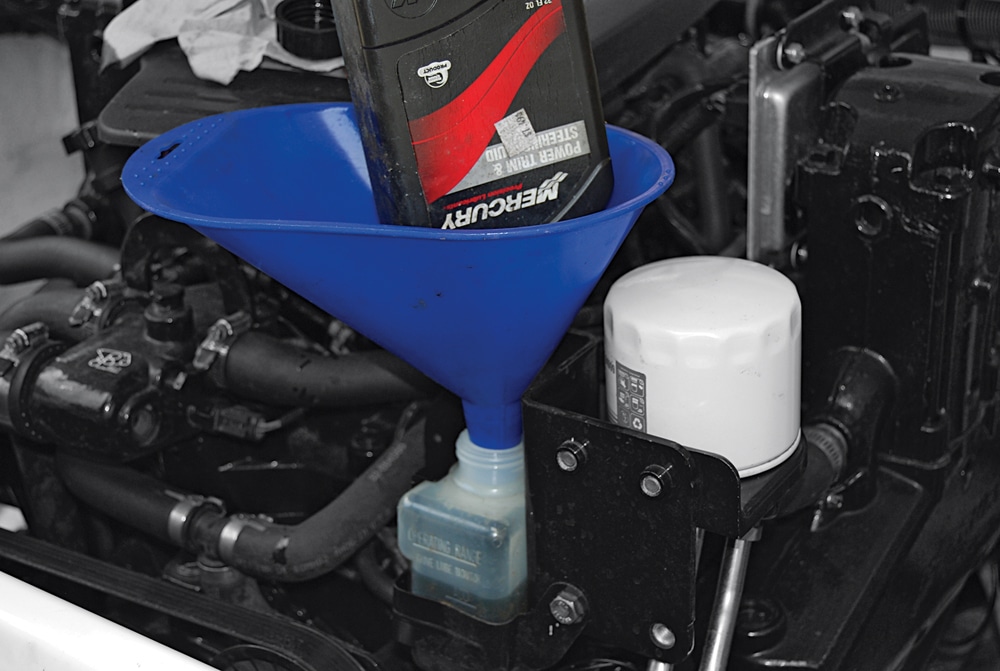
Top Winterizing Tips
This sterndrive has a remote fluid reservoir for the gear case and upper drive. Here, it’s being topped off after the drive was drained and refilled with fresh fluid. Boating Magazine
The next best solution is to keep the tanks nearly full to reduce the potential for condensation in the tanks. Just be sure the fuel in the tank, lines, filters and engine is all treated well; this requires running the engine until the treated fuel thoroughly circulates inside — typically at least 30 minutes at idle speeds, considerably less if you can run the engine at higher speeds. That’s why I suggest planning to run winter-stabilized fuel during your last few trips. If you do so, make sure to top off the tanks with a smidge more fuel and treat that too.
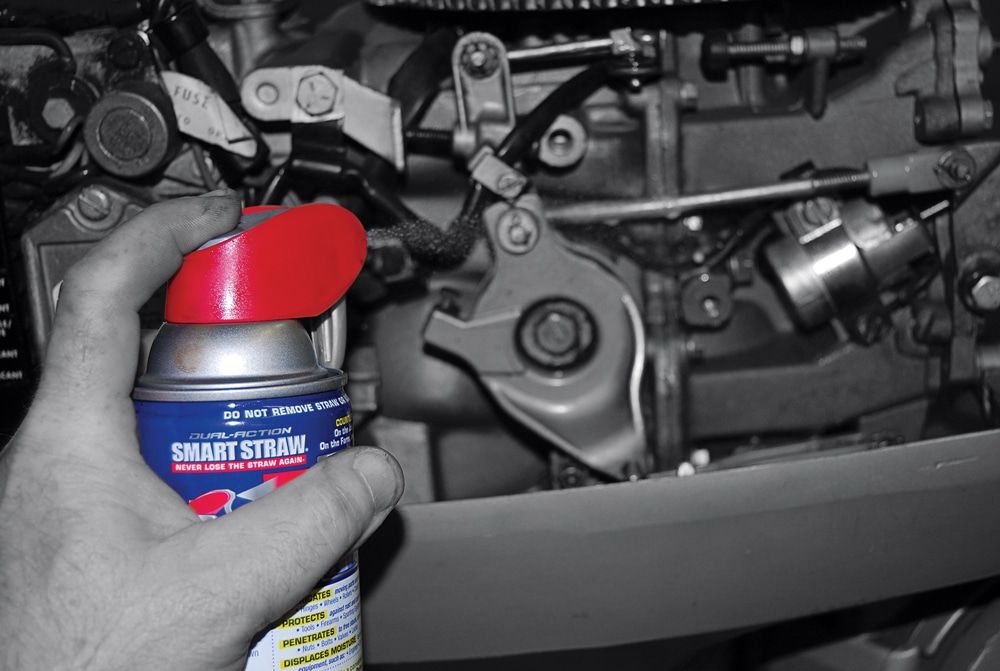
Top Winterizing Tips
Regardless of type, degrease your engine and then spray the entire block, linkages and wiring with silicone or other lubricant that dries to a waxy film. This prevents corrosion and allows you to spot loose fasteners, chafed wires and other maladies. Boating Magazine
If you run a boat powered by a two-stroke outboard, consider adding a fuel decarbonizing treatment to the fuel supply (in addition to the aforementioned fuel conditioner) before winter shutdown and storage. These additives are powerful agents for removing built-up carbon from cylinder heads and piston tops and sides, and from piston rings and ring grooves. This helps boost compression back to near-original specification levels on older engines and can reduce the chance of ring sticking — a death knell for an older two-stroke. A sticking piston ring won’t transfer combustion heat to the engine cylinder walls as designed, and the piston can heat up, expand and “grow” in size under load, causing expensive engine failure if gone unchecked. Sea Foam is an excellent aftermarket decarbonizing agent (seafoamsales.com) that I have used; you can also buy the original manufacturer’s decarbonizing additives directly from the local dealer of your particular brand of marine engine.
It needs stating that there are many aftermarket “no-name special” additives available. These are to be avoided. Stick to the recommendations made here, defaulting to the additives and sprays sold by your local certified outboard dealer when there is any doubt.

Use only biodegradable antifreeze to pour through the cooling system to flush out all water, and prevent any chance of freezing in winter. Boating Magazine
Flush and Drain
Flushing the engine’s cooling system with fresh, clean water is usually done at the same time as running the engine to distribute the fuel conditioner and fog the engine. Again, the savvy winterizer thinks ahead: The engine needs to be hot for the oil change, so that is done first, before flushing and finally fogging and filling with antifreeze.
When flushing, adhere to the manufacturer’s instructions. Flushing the engine, especially before a long layup, is crucial to its long-term survival — notably if you run it in salty, brackish, silty or otherwise dirty water.
When done, all water should be drained from the engine and drive to reduce the chance of freeze damage. Outboards can be drained simply by trimming them to the full-down, running position. Allow all the water to drain from the power head through the propeller and/or exhaust outlets. Sterndrives should also be stored trimmed down, though it’s prudent to remove the drive to check the bellows, gaskets and other gear, in which case it’s best to store the drive inside.
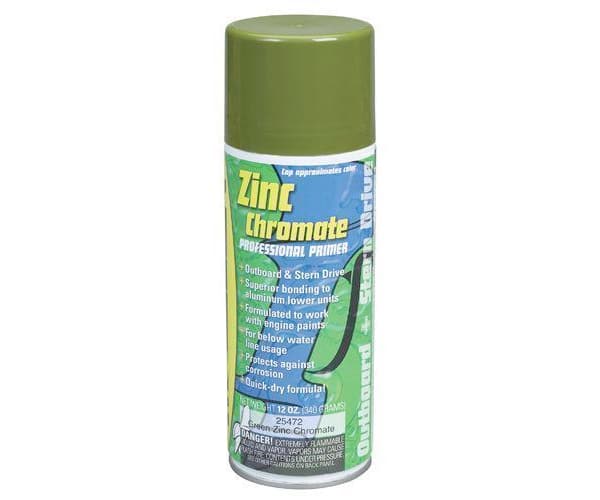
Everybody kisses ground once in a while. It’s important to repaint scuffed aluminum like outboard gear cases and sterndrives. Sand the area with 150-grit paper, wipe clean with white vinegar, and then immediately apply the first of several coats of zinc primer. Then overcoat with colored paint to match. Boating Magazine
Newer sterndrives and inboards have three or four block drain plugs; here is where a service manual is almost a must. Your engine may have block drains, exhaust manifold drains, power steering cooler drains, oil cooler drains and/or fuel canister drains. Be sure to remove them all or freeze damage could occur.
Older sterndrives and inboards typically have brass drains in the lower crankcase and also in the bottoms of the exhaust manifolds. Often, these can get clogged with rust flakes and debris from the cooling passages. A small wire or a pipe cleaner must be run up inside these drains to loosen any debris to allow water to drain. Don’t stop probing them until you are sure all the water has drained.
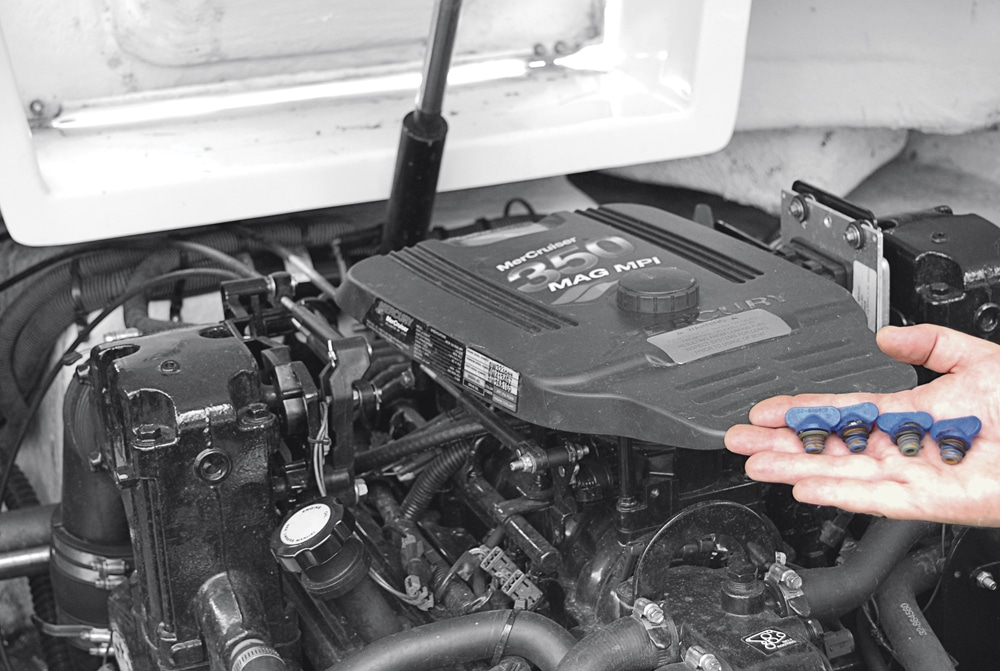
Top Winterizing Tips
Engine drain plugs must be removed and stored in a place where you won’t forget them next spring. Also, swirling a pipe cleaner inside the ports where the plugs were removed will help ensure that all water has drained. Boating Magazine
Regarding inboards and sterndrives with closed-loop freshwater cooling systems: Drain and change the coolant because, over time, coolant will lose its anti-corrosion properties.
For the raw-water cooling circuit, if yours has a freshwater flush connector, use it. If not, close the intake seacock and disconnect the hose on the outlet side of the raw-water pump. Disconnect the cooling-water discharge hose from the exhaust manifold or riser. Next, run fresh water into the discharge hose to back-flush raw-water passages and rinse out salt deposits. Make sure all the water drains out.
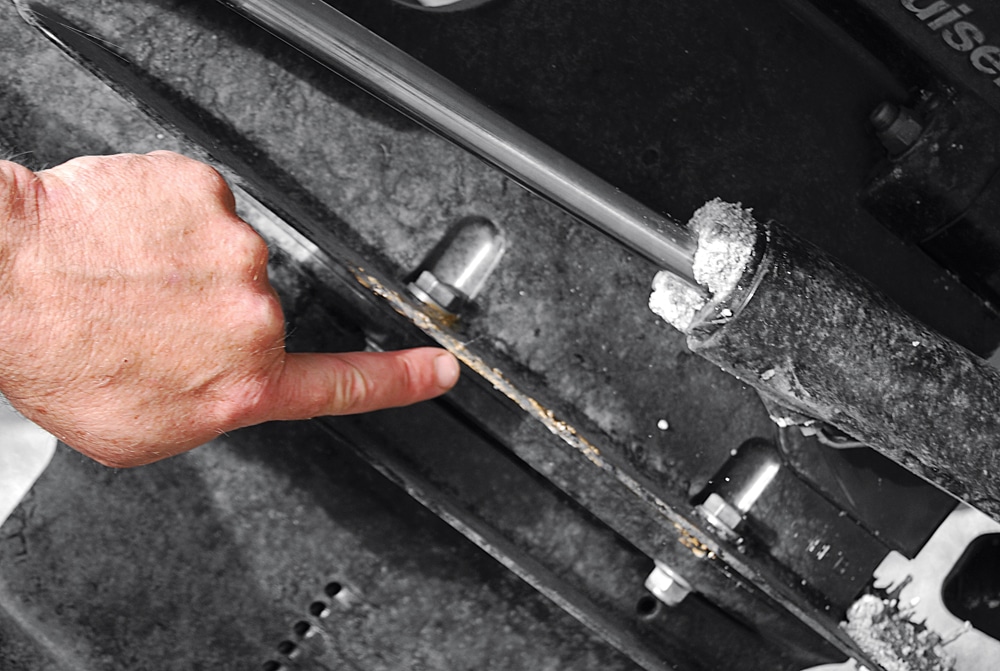
Top Winterizing Tips
This aluminum sterndrive has begun to corrode from galvanic action. The “hoary” condition of the sacrificial anodes would have been an early giveaway, but at least it was caught during a proper winterization in which the “zincs” (these are actually magnesium) were replaced. The source of the corrosion must be eliminated. Boating Magazine
To prevent corrosion and freezing from exposed metal or any residual water in the engine block of a raw-water-cooled engine or the heat exchanger of a fresh-water-cooled engine, take the following general steps, using your service manual as the final guide. Reconnect the water-pump outlet hose. Pour a 50/50 mix of propylene glycol antifreeze into the disconnected discharge hose until the hose is full. Allow the mixture to remain inside the block for several minutes. Open all raw-water drain plugs and drain the engine. This treatment leaves behind a layer of corrosion protection on the internal surfaces and keeps water that might be left inside the engine from freezing.
Remove the raw-water pump’s impeller. Antifreeze swells some rubbers, so rinse the extracted impeller as a precaution. Some boaters grease the impeller and reinstall it. This is fine, but I like to leave it out until spring so the vanes don’t take a set.
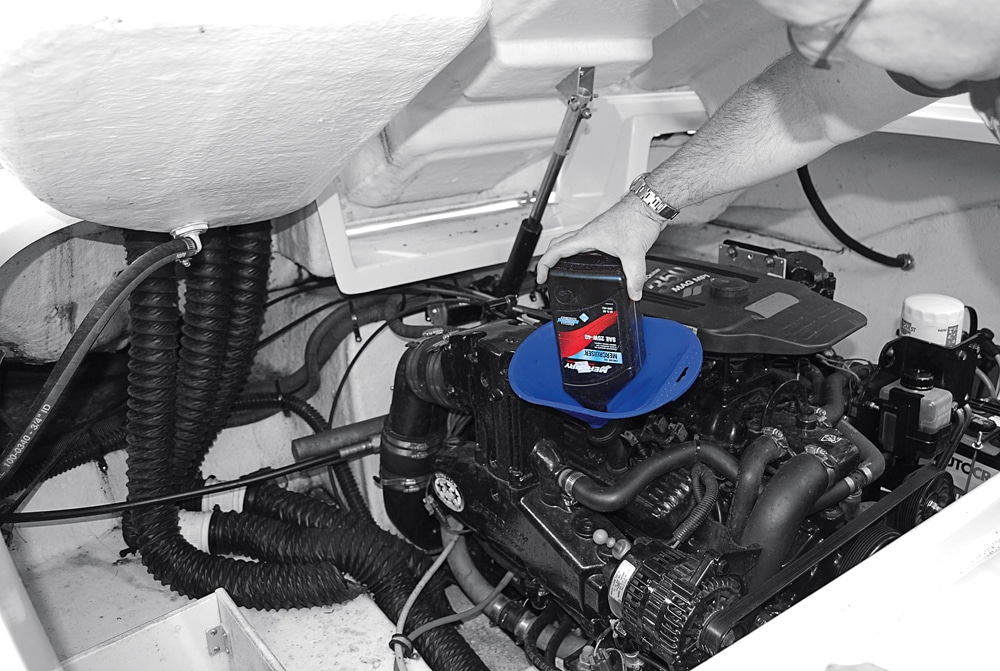
Top Winterizing Tips
Time your oil change for after you have fogged the engine. This way the engine is hot and the oil will flow nicely. Old oil can become acidic during the winter. Make sure you change the filter along with the oil. Boating Magazine
Lubrication
Engine oil, drive gear lube and transmission fluid should be drained and refilled. This is vitally important, because if there is water or other contaminants present, they must be flushed out. Any water that remains in the gear case, for example, will sit on steel shafts and bearings over the winter, coating them with rust. Your first trip out of port in the spring would likely give you a nasty and expensive surprise.
You’ll want to run the engine to warm the lubricants before draining, making them flow easier and also getting any contaminants into suspension so that they drain. Be sure to change the oil filter when you change the oil. You should also change the fuel filter. If your engine lacks a water-separating fuel filter, now is the perfect opportunity to install one.
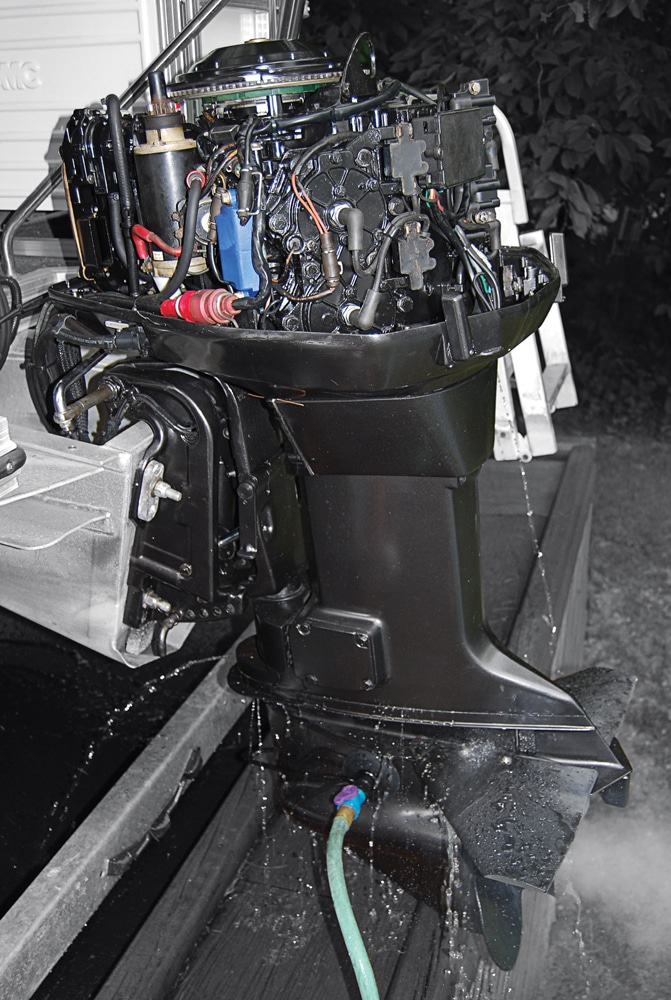
Top Winterizing Tips
“Fogging” means applying lubricating oil to cylinders and pistons while the engine is running. This can be sprayed in via carburetors or air intakes, or a special mixture can be supplied to the engine via a portable tank connected to the fuel line. Boating Magazine
Fogging
Call it “fogging,” “smoking” or “pickling,” the process of coating your engine’s internals with oil is an important winterizing task. While there are those who maintain that one need not fog a marine engine that has had stabilized fuel run through it, I believe in a proper fogging job. The engine should be “fogged” with a storage lubricant after it has been run awhile on the fuel mixture. This protects the bearings, seals and rotating surfaces with a thin film of protective lubricant, which helps keep rust and corrosion away. This can be done with the engine running; the fogging oil is squirted into the carburetors or fuel-injection system air intakes in such a way that it “floods” the engine with oil until it begins to smoke heavily. Continue fogging it until it stalls. Be very careful to not lose the little red straw on the spray bottle. An engine that ingests this hard plastic can sustain damage.
You can also apply fogging oil with the engine shut down, if you like, and if you have had stabilized fuel run through the engine. The spark plugs are removed and the oil is sprayed into each cylinder in turn. The flywheel is rotated manually or the kill-switch lanyard is pulled and the key switch energized to turn the engine over without allowing it to start. This helps to distribute the fogging oil throughout.
Winterization is a methodical process that keeps DIY boaters in better touch with their engines and their systems.









